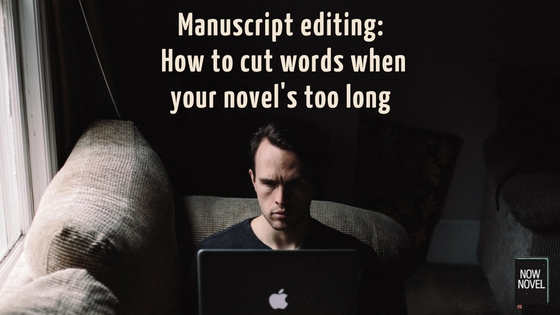In this guest post by author, blogger and writing teacher Janice Hardy, Janice shares tips for cutting words when your manuscript is too long.
Cutting words from your manuscripts doesn’t have to be a huge hack and slash deal. You don’t have to rip your baby to shreds. In fact, hacking away whole scenes often hurts more than helps, because you’re killing the story, not the extra words. You want to get rid of the words that aren’t helping the story.
Cutting Words Isn’t so Hard. No, Really
Cutting thousands of words from your manuscript seems daunting. Having to cut tens of thousands of words can make you want to curl up in a ball and cry, but it’s much easier than you think.
Let’s look at what “cutting words” means:
When is a manuscript “too long”?
A common “too-long” manuscript is 120,000-words, roughly 480 pages (based on the traditional 250 words per page format). You can cut 4800 words if you delete just ten words per page. Ten words is nothing—it’s one sentence in most cases, and even in polished and published novels you can still find one sentence per page that can go and not lose anything. Cut twenty words per page and that’s almost 10,000 words gone with little effort. A 150,000-word novel? 600 pages, and 6,000 or 12,000 words gone. Cut thirty words—18,000 words down.
Working with words-per-page is much more manageable because you can trim consistently across the entire novel, not just certain sections.
Step One: Decide how much you want to cut
You might have a fixed number in mind, such as 90,000 words, or a sliding scale, such as 80,000-90,000 words. You could also decide to cut in stages, taking out half of the target and then seeing how the manuscript flows before doing anything else.
Step Two: Decide Where it Needs the Cutting
You can trim most manuscripts overall, but some will be heavy in one area and need specific trimming. Looking at the novel’s structure is an easy way to determine where the extra words lie.
Using the basic three-act structure, write down the word count of each act. (Feel free to use whatever structure you prefer and just adjust your percentages to fit your structure.)
Act one is the first 25% of the manuscript, the second 25% fills the ramp up to the midpoint in act two. The third 25% is the ramp down in act two from the midpoint, and the final 25% is in act three. So, if your manuscript is 100,000 words, you’d have four chunks of 25,000 words in each. At the end of each act, you’d have a major plot turning point.
Remember—these guidelines aren’t exact, but if (using the above example) you discover the first act is 35,000 words, but the rest fits your target word counts, there’s a good chance the beginning is too long. Then you should cut your extra words from there.
A 10% variance in section size is fairly normal, but anything beyond that needs a closer look. If you decide an act is working even though it’s longer, that’s okay. The goal is to use structure to diagnose and identify potential trouble areas, not force your manuscript to fit a particular template.
Step Three: Cut down the manuscript
Now comes the tough part, but you can do it. Take it step by step, page by page, and be ruthless. If your instincts are telling you what needs to go first, trust them.
Tricks to make manuscript editing and cutting words easier
If your words-to-cut number is daunting, it might help to trick your brain into thinking it’s not as bad as it looks:
Do the easy cuts first: Empty words, empty dialogue, unnecessary tags—cut all the words that commonly bloat a novel first. It is often surprising how many “only” “just” and “of the” a novel has.
Cut back to front: If you’re cutting words-per-page, start on the last page and work your way back. Not only will this keep you from getting caught up in the story, it won’t adjust the page count and cause you to cut more words from the front than the back as the novel tightens and becomes shorter.
Cut one chapter at a time in a new file: It’s a lot easier to hit that goal when you can see those words dripping off. And a bonus: by isolating the chapter, you can look at it more objectively and judge the pacing and flow.
Cut one act at a time in a new file: Same principle, just with more pages. This helps ensure you apply cuts evenly throughout your novel.
Set time limits on your cutting sessions: The longer you edit, the more likely it is you’ll let something slide because you’re tired and want to move on to the next part. Take a break between editing sessions and avoid this temptation.
It’s not unusual to need several editing passes to cut all the words you want out of a manuscript. The easiest words usually go first. Then, if you still need to trim, you have to make harder and harder decisions.
Have you ever struggled with a too-long manuscript?
About Janice
A long-time fantasy reader, Janice Hardy always wondered about the darker side of healing. For her fantasy trilogy The Healing Wars, she tapped into her own dark side to create a world where healing was dangerous, and those with the best intentions often made the worst choices. Her novels include The Shifter, Blue Fire, and Darkfall from Balzer+Bray/Harper Collins. The Shifter, was chosen for the 2014 list of “Ten Books All Young Georgians Should Read” from the Georgia Center for the Book. It was also shortlisted for the Waterstones Children’s Book Prize (2011), and The Truman Award (2011).
Janice is also the founder of Fiction University, a site dedicated to helping writers improve their craft. Her popular Foundations of Fiction series includes Planning Your Novel: Ideas and Structure, a self-guided workshop for planning or revising a novel, the companion Planning Your Novel Workbook, and Revising Your Novel: First Draft to Finished Draft.
*This article is an excerpt from Janice’s manuscript editing manual, Revising Your Novel: First Draft to Finished Draft



19 replies on “Manuscript editing: How to cut words when your novel’s too long”
Thanks for having me!
It’s a pleasure! Thank you for the helpful post, Janice.
You make it sound so easy! Actually, I know it WILL BE easier with this approach. “Baby steps!”
It’s much easier than you’d expect if you break it down to manageable chunks. You can eliminate so much at the word level you often don’t need to change anything about the story.
Great advice, Janice. Breaking the whole novel-writing process into manageable chunks from start to finish really makes the mammoth task that much less daunting.
Good advice. Step One = look before you leap. If making a major reduction in m/s size, hunting for individual words here and there may clearly not be enough to reach your goal. If so, look instead for big chunks: entire paragraphs, lines of dialogue, leisurely chapters. Look for places where you’ve used 500 words to show something that can be told in fifty. Conversely, look for sections where you’ve told something in 500 words that could be shown in 100.
If you’re close to your goal, then do a seek and destroy on short phrases, as above, including “tried to,” “started to,” “began to,” and the like. Watch for “stage management:” moving characters around without meaningful content, (“Jim locked his front door, then went down to the garage and started up his battered old Gremlin…”) instead of just jumping directly to the new location. (“It was raining when Jim reached the warehouse…”)
Every writer should study writing haiku to learn to stay within a limited word budget.
Love the idea of studying haiku. Practicing writing with constraints is great on multiple levels – both for cutting the chaff from your writing and for the creative possibilities unlocked by having to find alternatives.
A few useful thoughts on haiku are found here: https://jguentherauthor.wordpress.com/2013/05/11/why-you-cant-write-haiku-part-1/
Great tips, thanks for adding them! I have a list of “red flag words” to watch out for and all of those are on it. Good words to search for during an edit even if you aren’t trying to trim words.
Haiku’s a great way to teach yourself to write tight. Flash fiction is another option for tight plotting.
Thanks for the advice. I write much shorter books, about 60K, but I often go over. I’ll can scale it down.
Glad you enjoyed Janice’s post, Christy. A good novella is great – less of a time commitment but still the possibility of a satisfying story arc.
Only if it needs it 🙂 It’s more important to have a well-balanced novel with good pacing. Unless you have a hard word count limit for your publisher.
I recently finished my first book at it is at 122,000 words. I have already been through the editing process and in that I cut about 46,000 words while adding maybe 20,000 for a net of about 26,000 cut. My book has fast pacing despite the long word count, so I don’t feel anymore needs to be cut anymore.
That is a fairly large cut, it sounds like a reasonable length to me. Best of luck with the publishing process going forwards.
I don’t have a finished manuscript yet, but I can tell what I do have will need trimming. I’m saving this post for later. 🙂 Thanks for the tips!
It’s a pleasure! Glad you found them useful.
How is word count accurately determined? I’ve heard 250 words per page and I’ve heard that’s wrong. How and what goes into word count? (Thx)
Oh, my. I cannot thank you enough. I had a really fine agent tell me yesterday that my manuscript was really intriguing but I must cut it from 117,500 words to 85,000. It’s a fast-paced, carefully plotted sting. It would be dreadful to unravel and move things around. But with your advice – I don’t have to. I think I can do what you suggest. Page by page. Thank you!
Hi Brenda, that’s fantastic to hear. The fact an agent gave you such detailed advice means your MS really does have legs. I hope the cuts aren’t too painful and that you’re happy with the final outcome. Thank you for sharing your story with us. Keep us posted on further developments.